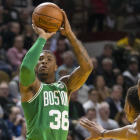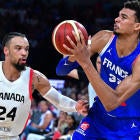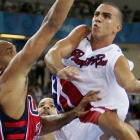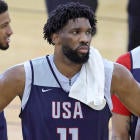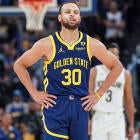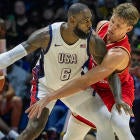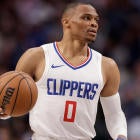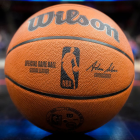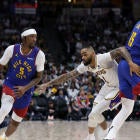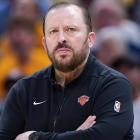Marcus Smart is the worst shooter in the NBA, at least right now. Of any player averaging at least 10 shots a game, Smart has the worst field-goal percentage, league-wide, at 28.1 percent. Of all players with at least 1,800 shots in their career, Smart has the 57th-lowest mark in NBA history.
It's not just jumpers, either. Smart is shooting 36.7 percent on layups this season, 10th worst in the league. In non-postup situations, Smart is in the second percentile league-wide in shots around the rim via Synergy Sports. (That means 98 percent of the league is better.) Smart has shot 9 for 35 on unguarded catch-and-shoot jumpers, which is only slightly better than his 7-for-30 mark on jumpers off the dribble.
OK, so Marcus Smart is a terrible, horrible, no-good shooter who clearly must be a liability to the Celtics.
Except ... when Smart is on the floor, the Celtics outscore their opponent by 11.3 points per 100 possessions (roughly one game). That's 7.9 points per 100 possessions better than when he's off the court. In other words, the Celtics jump from a solid team to an elite team when Smart is on the court.
But that's obviously the defense, right? After all, Smart is an omni-defender who can match up with all five positions, a bull in a china shop. The Celtics' defense is 1.5 points per 100 possessions better with him on the floor. That's where the good play comes from, right?
Except ... here's the thing ... when Smart is on the floor, the Celtics have a 106 offensive rating. That's second best among rotation players, and 6.8 points better than when he's on the bench.
How is it that the the worst shooter in the league helps make the league's best team better on offense?
The illusion of threat
Every day, you go in and you play. You practice and you practice and you play, over and over again, and you see the same actions over and over. You have certain things you just do, like defend against a guy driving to the rim, even if, in actuality, you are surrendering a worse outcome than you would if you just let him attempt a layup.
This is the beautiful secret to Marcus Smart's offensive success (with help from Brad Stevens and Al Horford).
Smart shot 1 for 8 from the field Tuesday night against the Nets. Yet Smart finished the game with a plus-6 and an excellent offensive rating of 110. How? Watch the way Brooklyn's defense reacts when Smart drives on a pick-and-roll:
That's three players crowding one of the worst scorers in the league.
Watch what happens here with the Atlanta Hawks as Smart comes around a double pick:
Not one, but two help defenders come over, leaving a wide-open passing lane to Jayson Tatum, who is shooting 48 percent from 3-point range to start his career, wide open in the corner.
Same deal here, the Hawks are committing to stopping Smart on the drive, despite the fact that he has only taken seven shots at the rim coming off the pick out of 101 pick-and-roll possessions. In this situation, Smart puts his defender behind him "in jail" (by pinning him back with his hips to keep him behind) and then the threat of -- I guess his runner? -- opens up the lob:
What we're talking about here is a form of gravity, a term so often talked about in terms of the Warriors. Teams don't guard against Rajon Rondo 3-pointers, even if his numbers say he's now a good catch-and-shoot shooter. But with Smart, no matter how he performs, they play him the same way: as an offensive threat.
Watch Kyle Lowry close hard to defend a Smart 3-pointer, leaving Jaylen Brown wide open (thanks to a crushing Aron Baynes screen):
Against the Magic, Smart's size worked to his advantage. He draws a mismatch in the post, and there's Horford feeding him. Nikola Vucevic then goes to help, despite Smart shooting 5 for 15 in the post this season, and the result is an open Horford 3-pointer.
The Smartest lineup
Horford is a key part of this, as he's playing the best ball of his career. But even then, Smart has a better offensive rating with Horford than even Kyrie Irving does. The green in this chart represents a notable number compared to the number below it.

There's overlap here; Smart and Irving are often together when they play with Horford, especially in crunch-time situations. But it's interesting that Smart's offensive rating without Horford is better (slightly) than Irving's without Horford. Also, the Celtics' offense has been better with Smart on-court and without Irving than it has with Irving on and Smart off.
Together, they've been dominant (again, in part thanks to Horford as well as Brown and Tatum).
Celtics offensive rating | |
With Smart, without Irving | 102.3 |
With Irving, without Smart | 100.6 |
With Smart and Irving | 111.3 |
Note that none of these numbers are great except when Smart and Irving (usually along with Horford) are together. The Celtics' offense remains a problem they need to fix; their strength is their defense by far. Boston is on pace for a historic defensive rating if it can keep this up. (Note: It will not keep this up.)
Again, context is needed. Who those players play with and against isn't factored in, and the sample size remains small. The central point remains: The Celtics offense has been as good with the worst shooter in the NBA on the floor as when its best offensive player is instead.
Misses vs. mistakes
Boston's turnover percentage drops by two full points (15.9 to 13.7) with Smart on the floor. The Celtics' effective field goal percentage of 49.5 somehow doesn't change with or without him, despite Smart's gruesome individual eFG% of 34.1.
A lot of this has to do with how Smart plays within himself. On the play below, Smart catches the ball with a chance for a wide-open 3-pointer here. If he takes it, it's a good shot. But he has Horford wide open in the corner with a man closing out on him. The extra pass creates an even better one.
(Also note the perfect spacing, great pass from Irving and both the devastating initial screen from Baynes and the subsequent screen underneath to prevent a run-out.)
Smart's not going "Rondo," meaning passing up open looks to hunt for assists. He's taking advantage of how the defense continues to cover him. In a playoff series, this can prove costly; teams will stay home and dare him to shoot. Smart still needs to improve that shot.
In some ways, he's like a poor man's Draymond Green, who the Celtics face Thursday in the week's titanic battle of the two best teams in the league at the moment. Green is a better finisher but is a career 33 percent 3-point shooter. Like Smart, he's defined by his bullying, overwhelming defense and like Smart, his sublime passing is often overlooked. Both operate as the emotional engines of their teams.
Given his defensive prowess and the way he provides an emotional energy to the team, it's clear it doesn't matter how Smart shoots.
He just makes the Celtics better.









